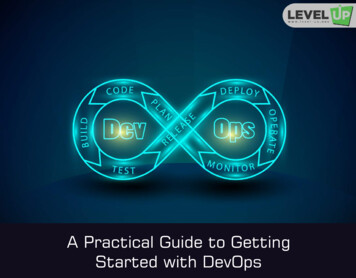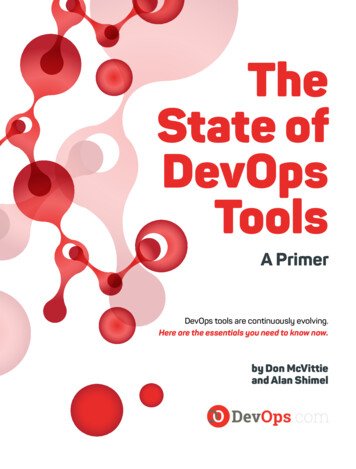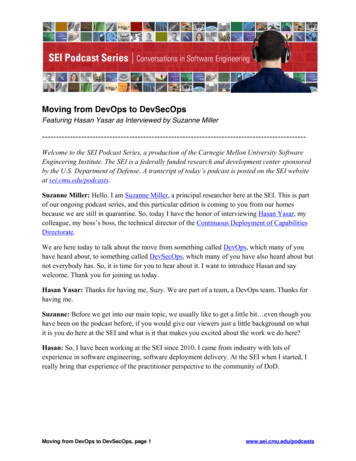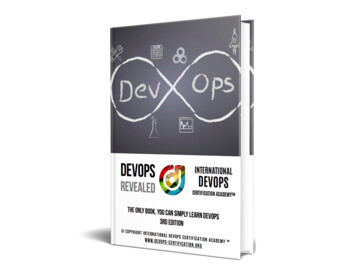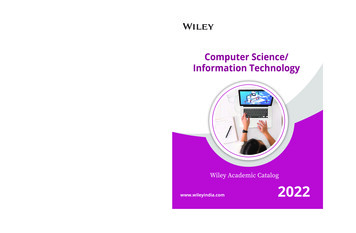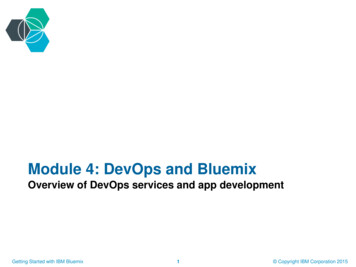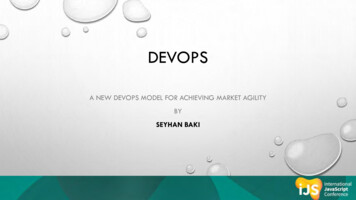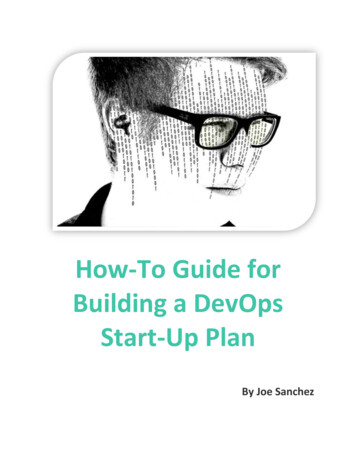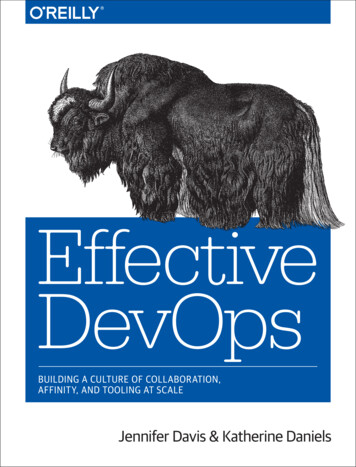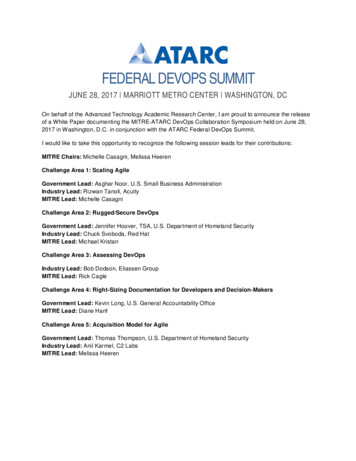
Transcription
FEDERAL DEVOPS SUMMITJUNE 28, 2017 MARRIOTT METRO CENTER WASHINGTON, DCOn behalf of the Advanced Technology Academic Research Center, I am proud to announce the releaseof a White Paper documenting the MITRE-ATARC DevOps Collaboration Symposium held on June 28,2017 in Washington, D.C. in conjunction with the ATARC Federal DevOps Summit.I would like to take this opportunity to recognize the following session leads for their contributions:MITRE Chairs: Michelle Casagni, Melissa HeerenChallenge Area 1: Scaling AgileGovernment Lead: Asghar Noor, U.S. Small Business AdministrationIndustry Lead: Rizwan Tanoli, AcuityMITRE Lead: Michelle CasagniChallenge Area 2: Rugged/Secure DevOpsGovernment Lead: Jennifer Hoover, TSA, U.S. Department of Homeland SecurityIndustry Lead: Chuck Svoboda, Red HatMITRE Lead: Michael KristanChallenge Area 3: Assessing DevOpsIndustry Lead: Bob Dodson, Eliassen GroupMITRE Lead: Rick CagleChallenge Area 4: Right-Sizing Documentation for Developers and Decision-MakersGovernment Lead: Kevin Long, U.S. General Accountability OfficeMITRE Lead: Diane HanfChallenge Area 5: Acquisition Model for AgileGovernment Lead: Thomas Thompson, U.S. Department of Homeland SecurityIndustry Lead: Anil Karmel, C2 LabsMITRE Lead: Melissa Heeren
Below is a list of government, academic and industry members who participated in these dialoguesessions:Challenge Area 1: Scaling AgileJohn Asbra, Pivotal Software; Tina Chang, USDA; Pryalal Karmakar, DHA; Ken Laskey, MITRE; JacquesMalebranche, GSA; Nicholas Pesce, MITRE; Sahar Sadeghian, MITREChallenge Area 2: Rugged/Secure DevOpsDurga Anakala, HUD; David Axinn, Pivotal Software; R.E. Baum, GitLab; Sean Burgess, USDA; PeterBurkholder, GSA; Mark Galpin, JFrog; Chris Goehring, Pivotal Software; Kyle Mach, DHA; Delbert Miller,DoS; James Mysliwiec, USAID; James Paschal, DoD; Mark Roth, USAFChallenge Area 3: Assessing DevOpsGary Alderman, HUD; Kevin Bierschenk, IRS; Dallas Blair, HUD; Alex Bois, Eliassen Group; Julio Burgo,MITRE; Thomas Chester, SEC; Mary Curtis, EPA; Brandon Dube, TTB; John Griffith, MITRE; ThomasHoffmann, IRS; Pamela Isom, USPTO; Deepak Kunal, USPTO; Daniel Ng, FDA; Atika Tabassum,Deloitte; Audrey Winston, MITRE; Annie Xiong, DeloitteChallenge Area 4: Right-Sizing Documentation for Developers and Decision-MakersAntoinette Bowser, DoS; Chris Campbell, GSA; Tina Chen, EPA; Greg Elin, GovReady; Tricia Iveson,10Novate; Clark Misul, IRS; Dennis Nelson, DLA; Amanda Racer, Census; Deanna Stanley, MITRE;Mark Webber, MITREChallenge Area 5: Acquisition Model for AgileEric Blank, EPA; Curtis Jackson, EPA; Giancarlo Osorio, DHA; Scott Overend, Eliassen Group; BradWintermute, FDAThank you to everyone who contributed to the MITRE-ATARC DevOps Collaboration Symposium.Without your knowledge and insight, this White Paper would not be possible.Sincerely,Tom SuderPresident, Advanced Technology Academic Research Center (ATARC)Host organization of the ATARC Federal DevOps Summit
2017 Federal DevOps Summit ReportMichelle Casagni, Melissa Heeren, Rick Cagle, Diane Hanf, Michael Kristan, Justin F.BrunelleThe MITRE Corporation1Tom Suder and Tim HarveyThe Advanced Technology Academic Research Center1APPROVED FOR PUBLIC RELEASE; DISTRIBUTION UNLIMITED. CASE NUMBER 17-3231-3. 2017 THEMITRE CORPORATION. ALL RIGHTS RESERVED.
Executive SummaryThe second ATARC (Advanced Technology Academic Research Center) FederalDevOps Summit was held on June 28, 2017 in Washington, D.C. During this summit,five MITRE-ATARC Collaboration sessions provided representatives of industry,academia, government, and MITRE the opportunity to discuss challenges the governmentfaces using DevOps and Agile processes for software development and delivery. Thegoal of these sessions is to create an interactive forum for participants to exchange ideason best practices, recommendations, success stories, barriers and requirements to advancethe adoption of DevOps and Agile within the government.Participants ranged from Director, CIO, and other executive levels from government andindustry to practitioners from government, industry, and MITRE. Each collaborationsession had a MITRE, government, and industry lead to drive the discussions withsession participants towards addressing challenge areas in DevOps and Agile, as well asidentifying courses of action to be taken to enable government and industry collaborationwith academic institutions.This white paper summarizes the discussions in the collaboration sessions and presentsrecommendations for government, academia, and industry while identifying intersectingpoints among challenge areas. The sessions identified key overarching themes which aresummarized below.CultureAdoption of Agile and DevOps practices requires a shift in mindset and a change inprocesses. Several themes related to culture were discussed across the collaborationsessions: Leadership buy-in;Start small;Success is contagious; andFear of failure.Leadership buy-in is necessary for Agile to succeed in an organization. Communicationmust go up, down, and across to include all stakeholders, leadership, and developmentteams. Processes and procedures are going to change when adopting Agile and DevOps,and that change needs to be realized and accepted. Buy-in for Agile – scaled or not –needs to come from the top down with leadership in place to drive teams towardsdelivering value.Starting small and having impact that shows value to users will be contagious. As anorganization begins to adopt DevOps, start small and grow as successes are achieved andothers begin to see the value in Agile development. A first step could be adopting Agileapproaches to systems development life cycle (SDLC), upon which further culturaltransformation could be based. Establish specific measures to benchmark the startingpoint, and later demonstrate what is working and where to focus specific efforts aimed atfurther growth and maturity of any DevOps transformation.2
Fear of failure results in a slowdown of development and adoption of new processes.Managing Agile should be light-handed with the realization that failure will happen. TheAgile culture supports failing early and often to allow time for correction and morelikelihood of success. Instead of saying “fail fast”, the motto should be “learn fast”.People and ProcessesAgile and DevOps is less about technology and more about people and processes. Legacyregulation, business rules, procedures, and development techniques that drive currentprocesses are a mismatch with Agile and DevOps principles. Re-examining thesecomponents of the organization is critical to any needed organizational change to supportmodern software systems environments.It is important that all stakeholders understand that they need to embrace change andsimplicity, garner and react to rapid feedback, and be product (outcome) focused. In anAgile and DevOps environment, the rate of change is increased so that discussions anddecisions occur more frequently and – more importantly – less formally. Therefore, thereis a need to empower teams up front to make smart choices.It was further suggested through the collaboration sessions that Agile is not just fordevelopment, it can be used for cross-cutting practices to include organizationalprocesses. Also, government ownership of the development process will ensureconsistency across the program and teams.TrainingTraining should not be viewed as only necessary for developers; stakeholders andprogram/project managers should also be trained on the concepts and unique aspects ofAgile and DevOps to effectively execute, adopt, and manage them. Since thefundamentals of Agile and DevOps are not yet widely understood, education will go along way to helping stakeholders understand what is important in the newdeployment/development paradigm and help them better understand the changes andcommitment needed to adopt these methods.3
TABLE OF CONTENTSExecutive Summary . 21 Introduction . 52 Collaboration Session Overview. 52.1Scaling Agile . 62.1.1Session Goals .62.1.2Session Summary .62.1.3Recommendations .72.2Rugged/Secure DevOps . 72.2.1Session Goals .82.2.2Session Summary .82.2.3Recommendations .92.3Assessing DevOps . 102.3.1Session Goals . 102.3.2Session Summary . 102.3.3Recommendations . 122.4Right Sizing Documentation for Developers and Decision Makers . 122.4.1Session Goals . 132.4.2Session Summary . 132.4.3Recommendations . 152.5Acquisition Model for Agile . 162.5.1Session Goals . 162.5.2Session Summary . 162.5.3Recommendations . 173 Conclusion & Summit Recommendations . 174 Acknowledgements . 194
1 IntroductionThe second ATARC (Advanced Technology Academic Research Center) FederalDevOps Summit was held on June 28, 2017 in Washington, D.C. During this summit,five MITRE-ATARC Collaboration sessions provided representatives of industry,academia, government, and MITRE the opportunity to discuss challenges the governmentfaces using DevOps and Agile processes for software development and delivery. Thegoal of these sessions is to create an interactive forum for participants to exchange ideason best practices, recommendations, success stories, barriers and requirements to advancethe adoption of DevOps and Agile within the government.Participants ranged from Director, CIO, and other executive levels from government andindustry to practitioners from government, industry, and MITRE. Each collaborationsession had a MITRE, government and industry lead to drive the discussions with sessionparticipants towards addressing challenge areas in DevOps and Agile, as well asidentifying courses of action to be taken to enable government and industry collaborationwith academic institutions.The MITRE Corporation is a not-for-profit company that operates multiple FederallyFunded Research and Development Centers (FFRDCs)2. ATARC is a non-profitorganization that leverages academia to bridge between government and corporateparticipation in technology3. MITRE works in partnership with ATARC to host thesecollaborative sessions as part of the Federal DevOps Summit.This white paper is a summary of the results of the collaboration sessions and identifiessuggestions and recommendations for government, industry, and academia whileidentifying cross-cutting issues among the challenge areas.2 Collaboration Session OverviewEach of the five MITRE-ATARC collaboration sessions consisted of a focused andmoderated discussion of current problems, gaps in work programs, potential solutions,and ways forward regarding a specific challenge area. The sessions for this summitaddressed: Scaling Agile – when should you scale and what are the different methods ofscaling Agile?Rugged/Secure DevOps - how do you continuously modernize applications in aDevOps environment with security baked in?Assessing DevOps – how well is your DevOps process working and how do youimprove it?Right Sizing Documentation for Developers and Decision makers – Agile doesn’tmean NO documentation; how to incrementally develop documents and iew3http://www.atarc.org/about/5
Acquisition Model for Agile - applying Agile development practices with tailoredacquisition models.This section outlines the goals, themes, and findings of each of the collaboration sessions.2.1 Scaling AgileThis session focused on defining what it means to scale Agile and when is it appropriateto scale. It also discussed challenges, lessons learned and best practices for scaling Agile.2.1.1 Session Goals What does scaling Agile mean?When should you scale?What are different models/methods of scaling Agile to include lessons learnedand best practices?2.1.2 Session SummaryThe opening remarks to kick off the session outlined the goals and specified that thesession was not focused on one method for scaling Agile. Several different methods werelisted for the participants benefit, which included: Scaled Agile Framework (SAFe);Disciplined Agile Delivery (DAD);Large Scale Scrum (LeSS);Scrum of Scrums (SoS); andEnterprise Scrum.The session started with a discussion on the challenges faced by several organizationsintegrating new development using Agile into legacy systems and legacy developmentenvironments. Some challenges included different tools, contracts, and softwarearchitectures. Lessons learned from another organization suggested that communicationis key. There needs to be coordination between program management, developmentteams, and leadership to manage expectations and needs across all teams. There shouldbe a shared vision with a group understanding of the goal(s) so that everyone is driving tothe same outcome, no matter what development style is being used. It was indicated thateveryone wants success, so there should be an agreement on what success looks like andhow it can be measured.The discussion on using different tools and technology stacks across teams raised anotherconcern within the group. Some expressed that different technology stacks could createdevelopment silos while others questioned if this was the root of the problem for scalingAgile to multiple teams. The challenges faced by scaling Agile is not about thetechnology stack or tools, it is about the people and the processes. The recommendationof a shared vision and the fact that teams need to communicate and collaborate was raisedagain, pointing out that things are going to change and that change needs to be realizedand accepted. Buy-in for Agile, scaled or not, needs to come from the top down withleadership in place to drive teams towards delivering value.6
There were several points made about how to grow Agile organizationally. One memberof the group looked up a definition for scaling Agile online finding that there are twomodes: vertical scaling is about dealing with resistance up and down the chain andhorizontal scaling is bringing it to different parts of an organization. It was agreed thatscaling Agile is about bringing Agile principles into the whole organization and not justfor development; processes can also be Agile in nature. This aligns with the view thatAgile strategies should be tailored to address scaling challenges faced by developmentteams as well as adopting agility across the organization4. To scale, it was recommendedto start small and be successful. Starting small and having impact that shows value tousers will be contagious. It is also necessary for stakeholder mentality to consider valueto the consumer, not just a focus on schedule, budget and code produced. Once there areenough “small successes”, plan on how to grow, but don’t scale just to scale.2.1.3 RecommendationsWhen to Scale: Most organizations tend to scale Agile when the teams are getting big. Itwas recommended that Agile organizations have a shared vision and definition of successthat should be understood and agreed upon by all teams. There should also be a standardto follow that includes measures for success that leads to a cadence where everyone isseeing value.Lessons Learned: Leadership buy-in is necessary for Agile to succeed in an organization.As an organization begins to adopt Agile, start small and grow as successes are achievedand others begin to see the value in Agile development. Communication and training isalso critical. Communication must go up, down, and across to include all stakeholders,leadership, and development teams. Training shouldn’t be viewed as only necessary fordevelopers; stakeholders and program/project managers should also be trained on theconcepts and unique aspects of Agile to effectively execute adopt and manage Agileprocesses.Governance: Managing Agile should be light handed with the realization that failure willhappen. The Agile culture supports failing early and often to allow time for correctionand more likelihood of success.Methods for Scaling Agile: There are several different methods for scaling Agile.Choosing the method that works best for an organization may not mean using onespecific method; some organizations adopt best practices from different frameworks totailor an Agile process that meets their needs and culture.2.2 Rugged/Secure DevOpsThis session focused on answering questions surrounding the integration of security intoa DevOps culture and environment.4Ambler, S. & Lines, M. “Scaling Agile Software pment.pdf7
2.2.1 Session GoalsIdentify ways to continuously modernize applications in a DevOps environmentwith security baked inIdentify possibilities to break down monoliths and cut down batch sizesIdentify when to get Information Assurance (IA) involved in sprints and how tomove IA from waterfall to AgileIdentify how to integrate open source products into government operationalecosystemsIdentify the role of Authority to Operate (ATO) for DevOps toolsIdentify the ability to significantly shorten the time to achieving ATOs2.2.2 Session SummaryThe session began with participants stating the challenges in their organization withrespect to security and DevOps. There were several common themes that were discussed.In a fast paced – but cyber-centric – environment, the rules are constantly changing dueto emerging threats. Thus, patches and Security Technical Implementation Guides(STIGs) are constantly changing. Some organizations have the additional burden ofhaving to conform to compliance guidance of multiple organizations. Once anenvironment has been certified and accredited, it won’t need re-accreditation unless anemergency has been identified or a major release/change occurs. It is unclear how manyof these accredited environments are immutable in their architecture and implementation.Smaller releases were not considered to be material changes and thus not subject torecertification.The participants expressed frustration with the existing development and operations path.There is a general fear of failure and thus a resulting slowdown in development toaccommodate for additional processes. Several participants are working in anenvironment where the target production environment is a closed off environment due tosensitive processing so automated steps to employ Continuous Integration (CI) andContinuous Delivery (CD) across air gaps is currently impossible. Adding to thischallenge is the claim that security processes and threats are not always transparent, manyof the controls in the Risk Management Framework (RMF) have little to do with softwaredevelopment and cannot be automated, and there is a culture of being told “no”, whetherit be security teams, administrators, finance personnel, or others. There is a generalmisconception among the community that open source software is less secure than closedsource and that automated scanning tools result in too many false positives, slowing theautomation pipeline.The discussion moved on to questions that were posed by members of the room. Manyof these questions are based on the challenges previously mentioned. One individualasked if it was a good practice to involve developers in Change Configuration Boards(CCBs) to which the answer was “yes, if the process is Agile enough.” Most of thequestions revolved around the role of the security person such as “what is the righttaxonomy to use when developing software that a security expert would resonate with?”and if there are tools and automation steps that can automatically be triggered to generatevalid bodies of evidence that would be used in a security accreditation package. This8
created a debate around whether or not the velocity of incremental releases creates toomuch verbosity and if manual inspections are better than automated since automatedtesting results in a sense of control. The discussion moved on to questions aboutrefactoring, breaking up monoliths to more reusable microservices that can beindividually certified, and how to scan these microservices using newer technologies(such as containers).The group went on to discuss improvements in two areas: processes and people. Theconsensus in the room is that DevOps with an eye towards ruggedness and security is anevolution of the Agile development process with the need for security at all phases of thedevelopment cycle. Unlike Agile where breaking a build is forbidden, breaks andfailures are tolerated but won’t automatically be pushed to production and it is expectedthat some commits and check-ins will not make it through the complete CI/CD pipeline.On a security front, the output of the CI/CD pipeline can include artifacts and tests thatwill validate a continuous ATO accreditation so long as all the requirements are satisfiedin the pipeline, otherwise it will not deploy to production. Rather than thinking ofDevOps as a phase such as DevSecOps or SecDevOps, bringing it in everywhere resultsin the more ubiquitous, but clunky SecDevSecOpsSec title. This aligns with the cultureof treating security as a functional bug in software. All this, of course, will require ananalysis of time and money to implement.From a people perspective, the goal of adopting DevOps is to empower developers upfront to make a smart choice in the first place. Finding a change agent or a small team ofexcited people, representing a small vertical slice of the organization, is a good way tostart small with implementing DevOps in a new organization. Some ideas that werefloated around include enlightening the other roles in the organization througheducational opportunities. One suggestion was building 5-minute lightning talks tohighlight the perspective of a developer, operator, or security professional. Everyoneshould be a stakeholder, including customers and security professionals. This alsoextends to contractors augmenting the organic staff and mandating that they followcertain policies and processes to be open and collaborative and to define how they shalldeliver products. These discussed items help push back against a culture of fear whereinstead of saying “fail fast” with respect to security, the motto is “learn fast”.2.2.3 Recommendations Testing and securingo Look at how finance industry is doing securityo Test your application in simulated, but real-world environments such ascyber test rangeso Employ Continuous Monitoring in a production environmento Let security person decide what artifacts are needed and automatewhenever possibleo Determine what is necessary to be submitted for reaccreditation. “Noneed to submit user interface (UI) changes”, for exampleAutomate Configuration Change Board (CCB) processo Connect tracker software to CI pipeline to feed back into requirementsboards9
Deploying to Software as a Service (SaaS) or Platform as a Service (PaaS) mayreduce the number of required controls vs Infrastructure as a Service (IaaS)Use vendors to monitor upstream of open source communityCreate a developer golden image which is a development environment with preapproved products and libraries installed to minimize assessment of developmentlibraries2.3 Assessing DevOpsThe Assessing DevOps session proposed two fundamental questions. Firstly, “are youready for DevOps?” for attendees who were contemplating, but had not yet undertaken, atransformation of their software development lifecycle. It also asked, for those who werefurther along in exploring DevOps, “how well is your DevOps process working?”This group represented a great deal of diversity of familiarity and implementationexperience with fundamentals and tenets of DevOps. Among those early in theirconsiderations of adoption, questions of “what is the scope of DevOps?”, “what is notsuitable for DevOps?”, and “what are others doing for their assessments?” were foremoston their minds. Beyond those who were still considering a DevOps assessment for theirportfolio and programs, many were interested in discussing initial approaches, differingtechniques and priorities, and best practices being employed by other adopters.The group moved quickly from the early discussion of the opening questions, and settledon the narrower goal of addressing a framework for understanding how to begintransforming organizational structure and culture to prepare for adopting DevOps.2.3.1 Session Goals Are you ready for DevOps?How well is your DevOps processing working?Where should you begin a DevOps transformation?2.3.2 Session SummaryThe session began with introductions, which included organizational and domainperspectives, and interests in the goals of the session, as well as a statement of how faralong each representative and their organizations were in exploring DevOps. These earlyinputs included perspectives from those only just considering beginning their DevOpsadoption, as well as from those already engaged in some aspect of DevOpstransformation, such as deploying Infrastructure-as-Code (IaC), CI, or CD, and so forth.Many were interested in comparing techniques, learning from each other, and discussingemerging best practices or any approach to roadmaps for adoption. Several alsoexpressed interest in understanding how to migrate and manage legacy applications stillunder active development, and how to integrate compliance requirements into DevOpstools and processes.As the conversation opened, and the group began the work of the session to develop thetopic, discussion moved toward where to begin when considering a DevOps assessment.Seasoned adopters offered the advice to start with understanding the state of theorganization. In several cases, participants suggested identifying and cataloging any10
existing work to automate parts of the software development lifecycle (SDLC), as kernelsaround which a CI, testing, or deployment practice could be structured. Others built onthis, adding assessing other components of the organization critical to any neededorganizational change, such as people, processes, and tools already in place. Manysupported adopting Agile approaches to SDLC processes as a first step, upon whichfurther cultural transformation could be based. Further suggestions included startingsmall (even as a potential “skunk-works” approach) and establishing specific measures tobenchmark the starting point, and later demonstrate what is working, and where to focusspecific efforts aimed at further growth and maturity of any DevOps transformation.From this initial conversation, the group shaped and refined a more specific goal for thesession focusing on taking a first step toward DevOps adoption, and defining how toassess their existing organizational structure and culture, and legacy investments.With the ice broken, and the evolution of the session goal, most of the session consistedof a deep dive led by the session’s industry Lead. The lead guided the group through adiscussion of an example cultural assessment framework, with the acronym “STAR”.The framework consists of the Stories found in organizational cultures, the collection ofTaboos unique to each organization, the collection of shared Artifacts to be found in eachculture, as well as any defining Rituals practiced. For each area, members of the sessionoffered both positive and negative examples.The session participants began with consideration of what Stories were shared in culturesto explain what happened in the
Jun 28, 2017 · FEDERAL DEVOPS SUMMIT . JUNE 28, 2017 MARRIOTT METRO CENTER WASHINGTON, DC . On behalf of the Advanced Technology Academic Research Center, I am proud to announce the release of a White Paper documenting the MITRE -ATARC DevOps Collaboration Symposium held on Ju


